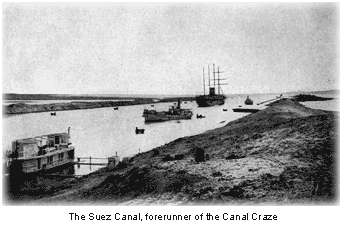Americans had realized for years the benefits that would come from connecting a major eastern city with the Great Lakes and surrounding heartland.
A canal embodied the potential to provide dependable and cheap transportation. The obvious drawbacks to the idea stemmed from topographical concerns—a canal would work well on relatively level land, but not in the mountains. Technology existed for construction of locks that would raise or lower boats to negotiate differences in elevation.
 A few short canals existed in the United States before the War of 1812, but DeWitt Clinton, mayor of New York City and later governor, became a passionate promoter of a lengthy canal to link his city with the Great Lakes. The Hudson River could be utilized to the Albany area, but from there to Buffalo required great quantities of money and engineering expertise. Thanks largely to Clinton’s persistence, the Erie Canal was completed in 1825. It cost more than $7 million and extended approximately 350 miles.
The Erie Canal was a financial success, returning a profit in its first year and paying off the construction debt in seven years. Small boats could manage the entire journey in three and one-half days. Other Atlantic port cities, Philadelphia in particular, felt the pinch; canal developers in Pennsylvania, Maryland and Virginia started their own projects, hoping to cash in on the success of the Erie Canal. This was the beginning of a frantic but short-lived “canal craze.” By 1840, 4,500 miles of canals had been built. Nearly all the imitators were failures, some resulting from construction difficulties and most from funding shortfalls.
The “canal craze” was abruptly ended by the construction of the railroads; the Erie Canal was a prominent exception, continuing to prosper for years after the Civil War.
A few short canals existed in the United States before the War of 1812, but DeWitt Clinton, mayor of New York City and later governor, became a passionate promoter of a lengthy canal to link his city with the Great Lakes. The Hudson River could be utilized to the Albany area, but from there to Buffalo required great quantities of money and engineering expertise. Thanks largely to Clinton’s persistence, the Erie Canal was completed in 1825. It cost more than $7 million and extended approximately 350 miles.
The Erie Canal was a financial success, returning a profit in its first year and paying off the construction debt in seven years. Small boats could manage the entire journey in three and one-half days. Other Atlantic port cities, Philadelphia in particular, felt the pinch; canal developers in Pennsylvania, Maryland and Virginia started their own projects, hoping to cash in on the success of the Erie Canal. This was the beginning of a frantic but short-lived “canal craze.” By 1840, 4,500 miles of canals had been built. Nearly all the imitators were failures, some resulting from construction difficulties and most from funding shortfalls.
The “canal craze” was abruptly ended by the construction of the railroads; the Erie Canal was a prominent exception, continuing to prosper for years after the Civil War.